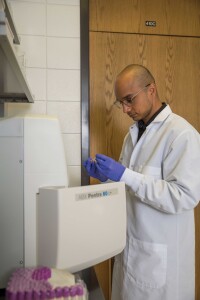Award-winning research doesn’t happen overnight.
Samitinjaya Dhakal M.S.’19, a South Dakota State University graduate student, found that out firsthand, through his research study “Effects of Lean Pork on Microbiota and Microbial-Metabolite Trimethylamine-N-Oxide: A Randomized Controlled Non-Inferiority Feeding Trial Based on Dietary Guidelines for Americans.”
The American Society for Nutrition honored Dhakal’s work with the Graduate Student Research Award—one of the highest honors for nutrition science students. He competed against 216 national and international graduate students including researchers from Cornell University, the University of Michigan and Purdue University, among others. Dhakal’s research was also recognized through ASN’s 2022 Emerging Leaders in Nutrition Science program designed for bright, upcoming doctoral and postdoctoral researchers. ASN is the preeminent professional organization for nutrition research scientists and clinicians around the world.
Journey to SDSU
Dhakal earned his undergraduate degree at Tribhuvan University in Nepal, about halfway around the globe. In pursuit of a master’s degree, Dhakal researched various U.S. universities to figure out where he wanted to go.
“I was exploring the faculty pages on the university websites for the kind of research I was interested in,” Dhakal said. “I was attracted by my (current) adviser’s (Moul Dey) nutriomics projects. Especially, merging metabolomics with nutritional health seemed really interesting due to the impact of the gut microbiota on human health.”
Dhakal was admitted to the M.S. in nutrition and exercise sciences program at SDSU in 2017.
The study
Dey, a professor in the School of Health and Consumer Sciences and Dhakal’s research project began in 2018 with funding from the National Pork Board and the National Institute of Food and Agriculture. Funding agencies had no role in the concept, design or outcome of the study. Dey explained that the study investigated Trimethylamine-N-Oxide (TMAO), a microbiota-dependent and primarily animal-protein-derived proatherogenic metabolite—a newer biomarker of atherosclerosis and a heart disease risk factor.
 Previous studies have suggested elevated levels of TMAO led to an increased risk for heart disease—the leading cause of death in America, according to the Centers for Disease Control and Prevention. The overarching belief, according to Dey, is that TMAO levels rise due to consuming red meat because of its precursors. However, all animal-sourced protein has TMAO precursors, Dey said.
Previous studies have suggested elevated levels of TMAO led to an increased risk for heart disease—the leading cause of death in America, according to the Centers for Disease Control and Prevention. The overarching belief, according to Dey, is that TMAO levels rise due to consuming red meat because of its precursors. However, all animal-sourced protein has TMAO precursors, Dey said.
“A Cornell University study reported individuals’ blood TMAO levels spiked the highest after consuming fish—much higher than after consuming beef,” Dey said. “However, we are told fish is a healthy option while red meat has always had a negative connotation—especially considering its association with TMAO.”
Researchers chose pork tenderloin—a red meat and the most popular animal protein worldwide—and chicken breast—widely recommended as a heart healthier option—as the two primary proteins for the randomized, controlled, crossover feeding trial.
The study’s hypothesis stated, “pork minimally impacts the gut microbiota and microbiota-dependent TMAO response in omnivores,” as outlined in their now-published research article in the Molecular Nutrition and Food Research journal, with coauthors Zahra Moazzami and Cydne Perry.
The trial saw 38 Brookings residents—50 years and older—follow a strict protocol, which required them to consume daily meals, snacks and drinks provided by the research team for 40 days. Meals were prepared from scratch following the 2015-2020 dietary guidelines for Americans.
The researchers collected blood, buccal swabs, urine and stool samples four times during the trial to assess targeted and untargeted metabolites as well as metagenomic changes before and after the consumption of pork or chicken.
Tightly controlled interventions with physiological and molecular endpoints, like this one, represent the “gold standard” for clinical nutritional research.
“It was a lot of work, but doing it this way helps minimize confounding effects, thus producing highest levels of evidence feasible in human nutrition research,” Dey said. “We are indebted to our study participants who complied well with our strict protocols.”
Results
At SDSU, Dhakal took courses in biostatistics, R programming and bioinformatics, which prepared him to analyze the massive data set of more than 350 biochemical changes in blood and more than 2,000 taxa of gut bacteria in hundreds of collected samples and replicates.
The data showed that substituting pork for chicken did not elicit a stronger TMAO response.
“What we found is that pork is statistically not inferior to chicken for TMAO,” Dhakal said. “Its impact on TMAO precursor compounds, markers of lipid metabolism, oxidative stress and blood pressure were also not different.”
“Instead of trying to say this is better and this is worse, we’re trying to say that they’re not really different using noninferiority trial design,” Dey said. “That is a robust but underutilized approach when looking at dietary impacts on health.”
Future plans
Over the course of this study, Dhakal began pursuing his doctorate. He will defend his doctorate dissertation later this year while also teaching as a part-time instructor at SDSU.
After graduating, Dhakal plans to stay in academia.
Addison DeHaven






